An official website of the United States government
 United States Department of Labor
United States Department of Labor
October 2010
Some of the largest industries in areas along the Gulf of Mexico Coast are related to oil and gas drilling, water transportation, and leisure and hospitality. A closer look at the occupations and wages in these industries and areas prior to the Gulf oil spill could provide insight into potential implications of the spill for the labor force in the region, although it is difficult to say which occupations may be adversely affected in their employment or wages.
While the largest occupations in the Gulf areas were often the same large occupations found in other areas of the United States, location quotients1 can be used to show occupations that are more highly concentrated in the Gulf areas than in other parts of the country. Location quotients compare an occupation’s share of total employment in the area to its share of total U.S. employment. A location quotient greater than one indicates that the occupation is more concentrated in the area than in the United States as a whole. Occupations that were the most prevalent in the 25 areas2 along the Gulf Coast, measured in terms of location quotients, are available in this table. Some of the occupations that were the most prevalent in the Gulf Coast areas included occupations associated with oil and gas extraction, water transportation, and leisure and hospitality.
Occupations closely related to oil and gas extraction and water transportation accounted for over 100,000 jobs across the 25 Gulf Coast areas. Six of the 19 metropolitan areas and 2 of the 6 nonmetropolitan areas had especially high employment concentrations of occupations prevalent in the oil and gas and/or water transportation industries. The location quotients for selected occupations in these 8 areas are shown in figures 1 through 4.
Four of the metropolitan areas—Beaumont-Port Arthur, Victoria, Lake Charles, and Houma-Bayou Cane-Thibodaux—are smaller metropolitan areas consisting of 2 parishes or counties and are shown in figure 1. The Houma-Bayou Cane-Thibodaux metropolitan area dominates the graph with four occupations with location quotients over 60, including captains, mates, and pilots of water vessels; riggers; sailors and marine oilers; and ship engineers. Chemical plant and system operators and petroleum pump system operators, refinery operators, and gaugers also had high location quotients for 3 of the metropolitan areas.
Click here to see these data in table format.
Houston-Sugar Land-Baytown, TX, and New Orleans-Metairie-Kenner, LA, also had high employment concentrations of occupations related to the oil and gas and water transportation industries. In many of the occupations, the metropolitan areas were similar in the concentrations of employment. For instance, both areas had similar location quotients for geological and petroleum technicians as well as petroleum pump system operators, refinery operators, and gaugers. Both areas also had high concentrations of petroleum engineers.
Click here to see these data in table format.
Two nonmetropolitan areas with high concentrations of oil and gas occupations are shown in figures 3 and 4. The New Iberia nonmetropolitan area is located in Louisiana and consists of Acadia Parish, Assumption Parish, Iberia Parish, Jefferson Davis Parish, St. James Parish, St. Landry Parish, St. Mary Parish, and Vermilion Parish. More than half of the 20 occupations with the highest location quotients in the New Iberia nonmetropolitan area were in some way related to the oil and gas industry or to water transportation. Employment concentrations for several of these occupations were more than 10 times as high in the New Iberia nonmetropolitan area than in the United States as a whole. For example, commercial divers were 124 times more concentrated in the New Iberia nonmetropolitan area than in the United States. The annual mean wages for almost half of these occupations also were above the U.S. all-occupations average of $43,460. For instance, petroleum engineers had an annual wage of $84,960 and a location quotient of 6.3. Captains, mates, and pilots of water vessels also had a high location quotient and an annual wage of $73,860.
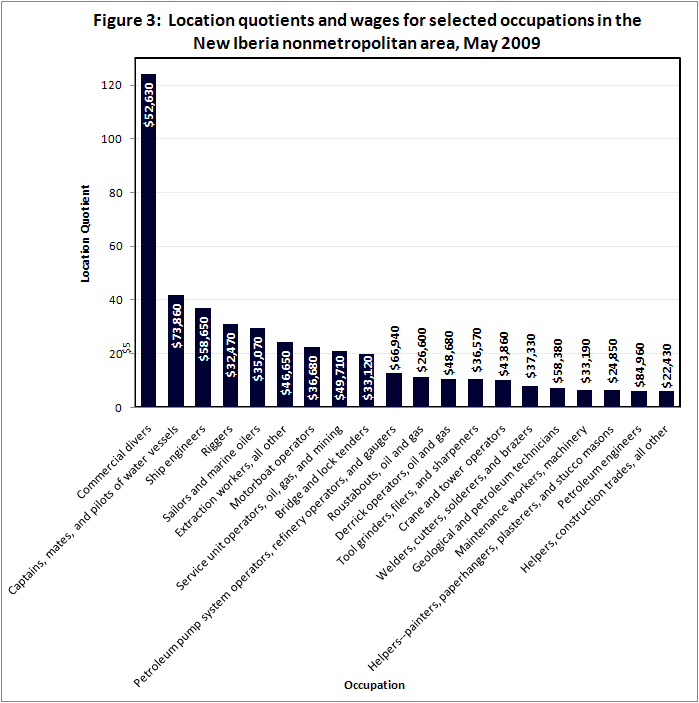
Click here to see these data in table format.
The Gulf Coast Texas nonmetropolitan area is located in Texas and consists of 17 counties. The occupations with the highest location quotients in this area were more diverse, and included a number of occupations not closely related to oil and gas extraction, such as postsecondary agricultural science teachers and personal and home care aides. Among the oil- and gas-related occupations, service unit operators, oil, gas, and mining had an employment concentration approximately 41 times the U.S. average. Petroleum engineers were also highly concentrated in this nonmetropolitan area, and had a high annual mean wage of $116,210.
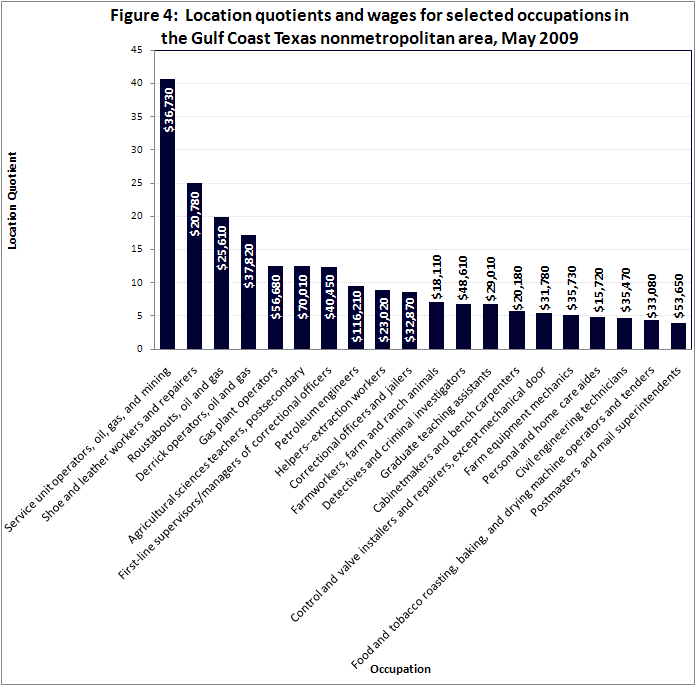
Click here to see these data in table format.
The proximity to water and the types of entertainment found around the Gulf Coast make it ideal for tourism and the service industries that support it, such as traveler accommodation and food service. Two metropolitan areas with high concentrations of leisure and hospitality-related occupations—Gulfport-Biloxi, MS, and Panama City-Lynn Haven, FL—are shown in figures 5 and 6. The occupations with high location quotients in Gulfport-Biloxi overwhelmingly consist of occupations that are directly related to gaming. Other leisure and hospitality-related occupations include concierges, baggage porters and bellhops, and lodging managers.
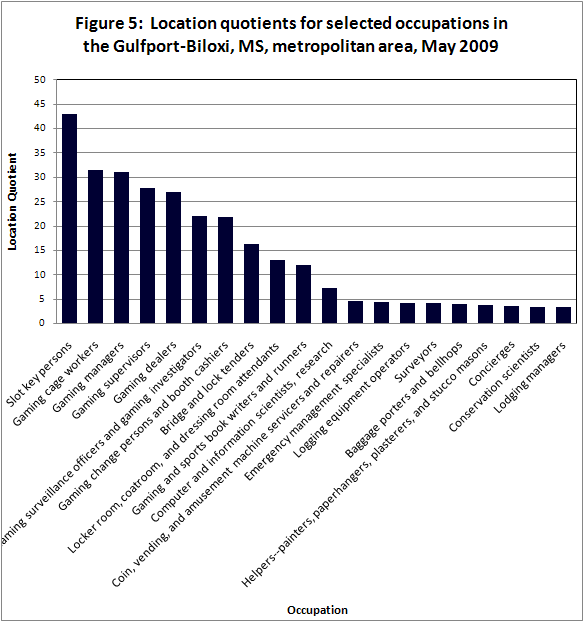
Click here to see these data in table format.
The Panama City-Lynn Haven, FL, metropolitan area also highlights the large concentrations of occupations in the leisure and hospitality industries. Particularly prevalent in this area were several occupations related to lodging and food service, including hosts and hostesses, restaurant, lounge, and coffee shop; hotel, motel, and resort desk clerks; and restaurant cooks. Like some of the other Gulf Coast areas highlighted above, this area also included high concentrations of sailors and marine oilers and captains, mates, and pilots of water vessels.
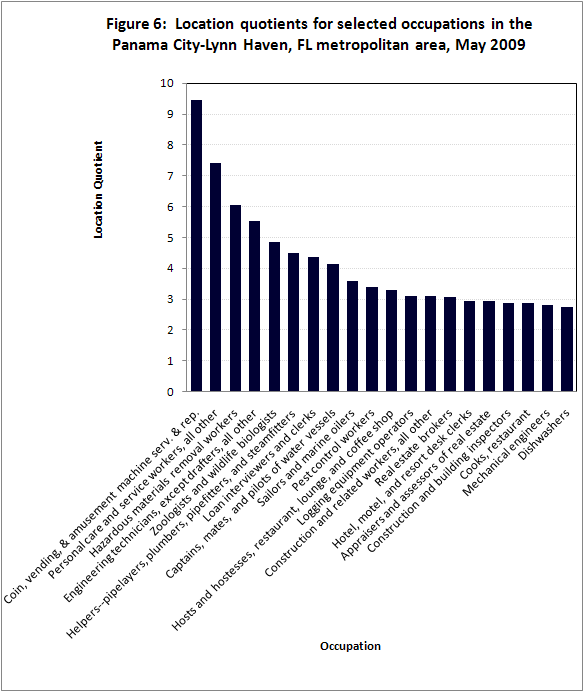
Click here to see these data in table format.
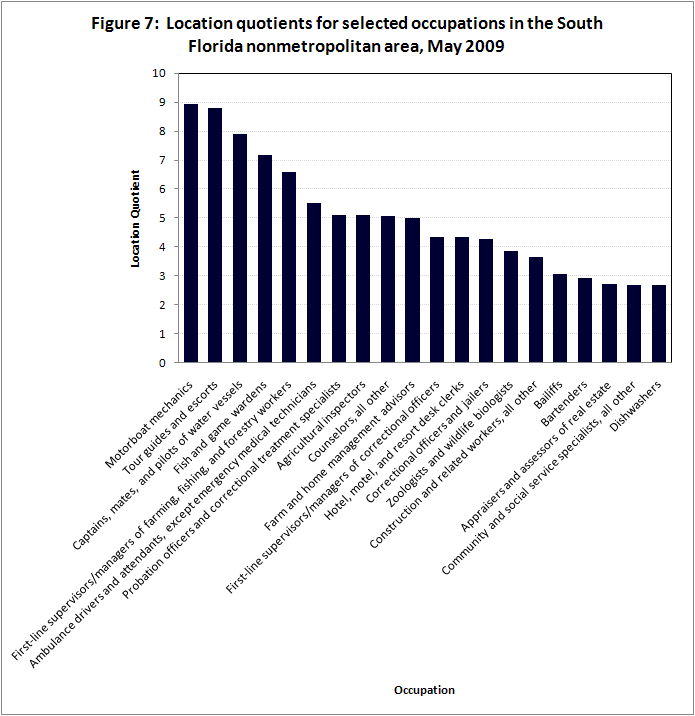
Click here to see these data in table format.
The South Florida nonmetropolitan area also had high concentrations of several leisure and hospitality-related occupations, such as tour guides and escorts, bartenders, and dishwashers.
In addition to the occupations highlighted above, other occupations were also prevalent in specific Gulf Coast areas. For example, several nonmetropolitan areas had high concentrations of protective service occupations, including the Northeast Florida, South Florida, and Gulf Coast Texas nonmetropolitan areas. The Southwest Alabama and Northwest Florida nonmetropolitan areas had high location quotients for logging occupations. Among metropolitan areas, McAllen-Edinburg-Mission, TX, had high concentrations of several teaching occupations, while Naples-Marco Island, FL, had high concentrations of construction and landscaping occupations. Although occupations associated with oil and gas extraction, water transportation, and leisure and hospitality were prevalent across the Gulf Coast region, individual Gulf Coast areas also retained some occupational diversity, suggesting that not every area may be equally affected by the Gulf oil spill.
Complete Occupational Employment Statistics data for May 2009 are available from the OES home page. This highlight was prepared by Swati Patel. For more information, please contact the OES program.
1Location quotients represent the ratio of an occupation’s share of total local employment to the occupation’s share of total U.S. employment. If a location quotient is equal to 1, then the occupation has the same share of area employment as it does of national employment. Location quotients greater than 1 indicate that the occupation makes up a larger share of local area employment than it does of national employment. For example, if the location quotient for tile and marble setters was 4 in the Naples-Marco Island, FL, metropolitan area, then that means that the employment share of tile and marble setters was 4 times as high in Naples-Marco Island, FL, as in the United States as a whole.
2The 25 areas include 19 metropolitan statistical areas (MSAs) and 6 OES-defined nonmetropolitan areas in Florida, Alabama, Louisiana, Mississippi, and Texas that border the Gulf of Mexico.
Last Modified Date: March 30, 2018